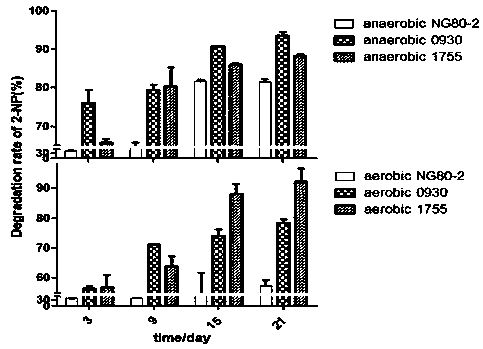Two high-temperature-resistant engineering bacteria capable of effectively degrading nitroalkane-type compounds
A nitroalkane, engineering bacteria technology, applied in microorganism-based methods, bacteria, microorganisms, etc., can solve problems such as mammalian carcinogenicity and human toxicity
- Summary
- Abstract
- Description
- Claims
- Application Information
AI Technical Summary
Problems solved by technology
Method used
Image
Examples
Embodiment 1
[0088] The clones (including the promoter part) of the full-sequence genes encoding nitroalkane oxidase GTNG-0930 and GTNG-1755 were constructed.
[0089] 1. Extraction of total DNA from Agrobacillus NG80-2
[0090] In this example, the Geobacillus thermodenitrificansFor NG80-2, take 3 mL of the fresh culture cultured overnight, collect the cells by centrifugation, suspend the cells in 250 μL of 50 mM Tris buffer (pH8.0), add 10 μL of 0.4M EDTA (pH8.0), and mix well at 37 °C Incubate for 20 minutes, then add 30 μL of 20 mg / L lysozyme, mix well and then incubate at 37 °C for another 20 min, then add 5 μL of 20 mg / L proteinase K, mix gently, then add 20 μL of 10% SDS, keep warm at 50 °C until the solution is clear, and use equal volumes of Phenol: chloroform: isoamyl alcohol extraction twice, chloroform: isoamyl alcohol extraction once, the last supernatant solution, add 2.5 times the volume of pre-cooled absolute ethanol, recover DNA, wash with 70% ethanol, precipitate dissol...
Embodiment 2
[0103] Geobacillus thermodenitrificans NG80-2 competent preparation and transformation process is as follows:
[0104] 1) Inoculate NG80-2 in 20 ml TGP liquid medium, culture overnight at 60°C in a shaker at 180 rpm.
[0105] 2) According to the proportion of 1% (v / v), inoculate the overnight cultured bacterial liquid into 50 mL of L TGP liquid medium, shake and cultivate on a shaker at 60 ℃ and 180 rpm until the OD600 is about 1.0~1.6.
[0106] 3) Place the bacterial solution on ice for 10 min.
[0107] 4) Transfer the bacterial solution into a 50 ml Beckmam high-speed centrifuge tube in an ultra-clean bench, centrifuge at 9000 g, 4 °C for 20 min.
[0108] 5) Discard the supernatant, add about 25 ml of competent cell washing buffer [0.5 M sorbitol, 0.5 M mannitol, 10% glycerol (v / v)] pre-cooled at 4 °C to resuspend the cells by shaking, Then make up to 50ml with washing buffer, centrifuge at 9000g, 4°C for 20min. This step was repeated 3 times, and the volume of washing...
Embodiment 3
[0116] Degradation experiment of 2-nitropropane
[0117] The engineered bacteria (NG-S1, NG-S2) and NG80-2 were inoculated into LB medium containing kanamycin and LB medium without kanamycin, respectively, and cultured at 60°C for 12 hours. Cells were harvested by centrifugation, washed twice with thermophilic minimal medium, and the cell pellet was resuspended. Under aerobic conditions, add 25 ml minimal medium containing appropriate antibiotics to a 100 ml headspace vial to a final concentration of 1.08 mmol 2-nitropropane. The anaerobic conditions were as follows: the minimal medium was boiled for 30 minutes to eliminate most of the dissolved oxygen, and placed in an anaerobic incubator to remove oxygen. Add L-cysteine and resazurin as oxygen reducing agent and indicator to the culture medium at final concentrations of 0.1% and 0.01 g / L, respectively, until the oxygen indicator in the culture medium turns colorless . Recombinant strains and NG80-2 were inoculated into ...
PUM
 Login to View More
Login to View More Abstract
Description
Claims
Application Information
 Login to View More
Login to View More - R&D
- Intellectual Property
- Life Sciences
- Materials
- Tech Scout
- Unparalleled Data Quality
- Higher Quality Content
- 60% Fewer Hallucinations
Browse by: Latest US Patents, China's latest patents, Technical Efficacy Thesaurus, Application Domain, Technology Topic, Popular Technical Reports.
© 2025 PatSnap. All rights reserved.Legal|Privacy policy|Modern Slavery Act Transparency Statement|Sitemap|About US| Contact US: help@patsnap.com



